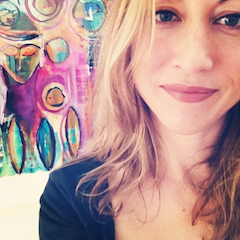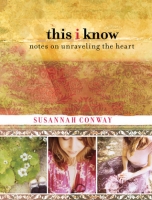In This I Know Susannah Conway tells her story of bereavement and her journey through grief, and yet it is not a sad book, but rather a most inspiring one.

About This I Know
On the one hand, it is inspiring because she had the rug pulled out from under her, had to walk through a valley of grief, and had to reinvent herself. And reinvent herself she did. From tentatively embarking on blogging in 2006, she now runs a successful business of teaching e-courses she created herself. Stories of triumph over tragedy are always inspiring, but this book is not only a memoir, it is also a creative journal. In her conversational tone, Susannah shares her creative tools — mainly through writing and photography — for not only overcoming tragedy, but for living a more mindful and creative life. The book’s central premise is: Here’s what worked for me, maybe it will work for you. Judging from the success of This I Know, it has hit the nerve of our times.
The Q&A
On the back cover of your book, Jennifer Louden is quoted as saying, “You will buy multiple copies of it to press into the hands of friends. You will mark it up with notes and read passages again and again.” This has been exactly my experience, and so I would love to hear how you conceived of This I Know. Was it a blog to book process?
Yes and no. It was my blog that initially caught the attention of a publisher, and there were a couple of blog posts that got woven into the book, but it was never our intention to take the content of the blog and turn it into a book. The blog is like the preamble, the training ground where I documented parts of my journey; the book is the result of six months of panning through the journey to finding the gold nuggets.
This I Know is an interesting mix of memoir and creative-how-to/inspirational book. How did you arrive at that hybrid form? Why not write straight memoir?
I never wanted the book to only be about my grief story, which is what I felt it would have been had it been a straight memoir. I wanted to write a book that shared stories from my life in a way that was inspiring for the reader. My life and experiences are the thread running through the pages but I hope the reader sees herself there, too.
Book stores need a label to shelf a book, and thus the publishing industry is reluctant to go with books that don’t fit into a straight jacket. Was it hard for you to find a publisher for this hybrid?
I was approached by my publisher so didn’t have to go through the pitching process, though I still had to write a proposal and have it accepted, of course. In most of the places I have looked, online and off, This I Know has been put in the Grief section, which is a shame as the book is about so much more than that, but I do understand that it has to go somewhere.
In This I Know, you share what worked for you in overcoming your grief over the sudden death of your partner and building a new life for yourself in the aftermath. Your girlfriend-to-girlfriend conversational tone makes your book very accessible. Have you gotten any pushback on how you shouldn’t be “giving advice” since you’re not an expert in the sense of being a therapist, or have readers accepted the book’s premise as the story of your journey? And along those lines, did self doubt rear its head as you were writing?
At its core This I Know is a book of personal stories, a record of my experiences that I hope is inspiring and comforting for the reader. It’s not a self-help book — and it’s not promoted in that way — and as you say, I’m not an expert either, but I am the expert of my own experiences. There are plenty of books about grief written by experts and I read all I could get my hands on in the first year of my bereavement. Some of them were helpful but many felt rather removed from what I was going through. I actually found more comfort in novels and autobiographies. Books like A Grief Observed by C.S. Lewis and Companion Through the Darkness by Stephanie Ericsson were so much more relatable for me. So as I wrote the book it was important to me that my words would reach the reader where she was on her journey. I haven’t received any pushback personally, and I do think that the reader can sense I’m sharing my story rather than dishing out prescriptive advice. There was plenty of self-doubt as I wrote, of course, but I think there is for most writers, especially with a first book!
You mention that you see yourself first as a photographer and second as a writer. The atmospheric Polaroid photographs included in your book are a great testament to your skills as a photographer. Do you still process life mainly through taking photographs, or has writing taken on a larger role since you’ve become a published author?
I couldn’t live without either — journaling keeps me sane and allows plenty of introspection while taking photographs keeps me present in the moment and gets me out of the house.
You say that photography has become a form of meditation for you, a way to plant yourself squarely in the moment and become more present. However, I have found that with a camera in hand I can be too obsessed with taking pictures and won’t be present because I am busy framing an experience through the viewfinder. Do you ever worry about missing out because you’re looking at life through a camera?
Yes, I’m very mindful of how I might be missing out if I’m always taking pictures, which is why I like to use my iPhone — I find it lets me take pictures quickly and be in the moment, rather than stepping out of the moment as I would with a larger camera (even my Polaroid). There are still times when I consciously put the camera away to just be where I am. Other times the camera helps me pay more attention. When I’m alone, the camera is my aide; when I’m with others, it can be a distraction. However, I never have photos I wish I hadn’t taken but often there are ones I wish I HAD. It’s a delicate dance.
You present photography as a way to see yourself and introduce the reader to the idea of doing self portraits, even if just of body parts. Obviously self portraits are a tradition in the visual arts but could you explain the theory behind them? Why is it good practice to portray oneself? And how did you realize this could be therapeutic?
Self portraits are a wonderful way to see ourselves, to record our lives with us in them. Cameras usually come out on special occasions, but I believe it’s worth recording the less obvious moments, too. A lot of the women I work with snap pictures of their family yet are rarely present in the photographs themselves. Self portraiture is a great way to make friends with the camera — you have control and you get to say which photos are kept and which are deleted. There’s this idea that taking self portraits is a sign of vanity, but I think it’s the opposite. It can be such a tender and humbling experience.
I studied photography at art college and took plenty of self portraits as a 20-something, but it wasn’t until my bereavement that I truly understood the power of this practice. For me it was a way to ground myself back in my life at a time when I felt I didn’t have much to live for. It became a way of saying to myself I am still here. I am still alive.
I am going to ask the question that is always asked of memoir writers: How did your family react? Did they have qualms about being in the book, not only in the family stories but also in photographs? Did you feel any restraints in writing about your family?
My family loved the book and had no problem being featured in stories or photographs. I would never have written anything that could have hurt them, but that doesn’t mean I didn’t write truthfully. Luckily mine isn’t a story filled with too many despicable deeds!
I love your list of book friends at the end. You say that, “It was Julia Cameron’s The Artist’s Way that started all this.” Can you elaborate? Does your creative practice include her famed Morning Pages and Artist’s Dates? If so, I’d be interested to hear how you’ve made them work over time. After all, as you so nicely say, “Looking after ourselves requires such vigilance, such commitment.” (p. 113)
I discovered The Artist’s Way when I started blogging back in 2006 and was inspired to go on Artist’s Dates with my cameras. I’ve tried Morning Pages on and off over the years, but what suits me best is journaling whenever the need arises. As soon as I try to implement a rigid routine, I want to rebel, so these days I journal as much or as little as I need, whenever I need it.
You’ve made a successful business out of yourself by packaging your own creative approach into well organized and stimulating online classes like your now classic Unraveling or Photo Meditations. How do you ensure that the business side of your life does not devour the creative side? How do you find enough time to do your art?
My business side IS my creative side — I can’t separate the two. I’m so grateful to be doing work that allows me to be creative, and I’m always looking for ways to innovate and improve. There are parts of my day that are less fun, for sure — the never-ending barrage of e-mail can be tiring, and certain administrative tasks drive me nuts. But then there are the days when I can sink into a big project — a new course, the next book — and all my creative superpowers come out to play. I work from home so it’s easy to work late into the night, and I usually work through the weekend, too. But this work is my passion. There’s nothing else I’d rather be doing.
Do you have another book project in mind?
Yes, indeed! I’m currently working on a new photography book for Chronicle Books and am sketching out ideas for a follow-up to This I Know.
Interviewer Annette Gendler is a nonfiction writer and teaches memoir writing at StoryStudio Chicago.

